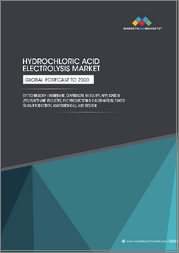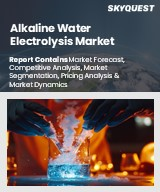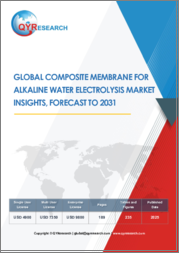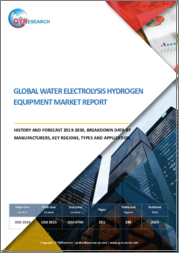
|
시장보고서
상품코드
1718078
세계의 물 전기분해 시장 : 기술 유형, 용량, 컴포넌트, 최종사용자별 - 예측(2025-2030년)Water Electrolysis Market by Technology Type, Capacity, Components, End-User - Global Forecast 2025-2030 |
||||||
물 전기분해 시장은 2024년 66억 7,000만 달러로 평가되었습니다. 2025년에는 71억 4,000만 달러에 이르고, CAGR 7.33%로 성장하여 2030년에는 102억 달러에 달할 것으로 예측됩니다.
| 주요 시장 통계 | |
|---|---|
| 기준 연도 : 2024년 | 66억 7,000만 달러 |
| 추정 연도 : 2025년 | 71억 4,000만 달러 |
| 예측 연도 : 2030년 | 102억 달러 |
| CAGR(%) | 7.33% |
수전해는 청정 에너지 분야의 핵심 기술로 빠르게 발전하고 있으며, 지속 가능한 에너지 운반체로서 수소의 생산 방식을 근본적으로 변화시키고 있습니다. 이 종합적인 개요는 시장 도입을 가속화하고, 기술 혁신을 촉진하고, 산업적 응용을 확대한 요인을 밝힙니다. 최근 몇 년 동안 탄소 배출량 감축에 대한 압력이 증가하고 에너지 다변화의 필요성이 증가함에 따라 수분해 기술에 대한 투자와 연구가 활발히 이루어지고 있습니다. 현재 기업, 투자자, 정책 입안자들은 수전해를 수소 경제의 새로운 기회를 열어주는 전략적 도구로 간주하고 있으며, 전 세계 에너지 인프라를 변화시킬 수 있는 발판을 마련하고 있습니다.
현재 시장 환경은 기술적 혁신, 규제 지원, 환경적 책임에 대한 세계 인식이 민첩하게 상호 작용하여 혜택을 누리고 있습니다. 이해관계자들은 이 분석을 통해 수전해 시장을 정의하는 주요 동인, 과제, 잠재적 기회를 더 깊이 이해할 수 있습니다. 첨단 분석 기술, 다양한 생산 규모, 구성 요소 최적화에 대한 초점은 모두 지속 가능한 미래를 그리는 데 매우 중요한 역할을 해왔습니다. 업계가 혁신을 거듭하는 가운데, 의사결정자들은 현재의 성과와 미래의 경로를 평가하는 데 필요한 미묘한 맥락을 제공받게 될 것입니다. 이 소개는 저탄소 경제로의 전환에 있어 수전해를 중요한 요소로 활용하기 위해 연구, 공정 강화 및 재생 가능 에너지 원 통합에 대한 지속적인 투자를 촉구하고 있습니다.
수전해 시장의 변화
수전해 부문은 산업의 원동력을 재정의하고 성능의 새로운 벤치마크를 설정하는 일련의 변혁적 변화를 겪고 있습니다. 기술 발전은 새로운 전극 배합에서 고효율 셀 설계에 이르기까지 밸류체인 전반의 혁신을 촉진하고 있습니다. 대규모의 자본 배분과 연구 이니셔티브를 통해 기업들은 에너지 소비의 비효율성 및 재료의 내구성과 같은 오랜 문제를 극복할 수 있었습니다. 그 결과, 이 분야는 공정의 신뢰성이 향상되고 생산량의 안정성이 개선되었습니다.
정부의 장려책과 지원 정책은 투자와 전략적 협력을 위한 견고한 프레임워크를 구축함으로써 이러한 변화를 더욱 촉진했습니다. 재생 가능 인프라에 대한 투자는 더 엄격한 배출 규제와 함께 더 깨끗한 생산 방식에 대한 패러다임의 변화를 일으켰고, 대규모 시범 프로젝트 증가를 촉진했습니다. 또한, AI를 활용한 공정 최적화와 같은 디지털 기술의 통합은 실시간 모니터링과 적응형 제어를 가능하게 하여 생산 공정이 빠르게 진화하는 시장 수요에 부합할 수 있도록 했습니다. 이러한 대대적인 변화는 이 분야를 지속 가능한 에너지 솔루션의 최전선으로 끌어올렸을 뿐만 아니라 비용 구조와 운영 모델을 재정의하고 장기적인 산업 회복력을 위한 길을 열었습니다.
또한, 경쟁 환경의 진화는 업계 관계자들 간의 협력 관계를 강화하고 기술 전문 지식과 모범 사례를 신속하게 공유하도록 촉진하고 있습니다. 이러한 협력 정신은 시장 참여자들이 과학적 전략과 상업적 전략을 통합하는 보다 종합적인 접근 방식을 채택하도록 유도하고 있습니다. 완전히 통합된 수소 경제로의 전환이 진행됨에 따라 주요 성과 지표가 재정의되고 지속 가능한 에너지의 미래를 향한 적극적인 노력을 반영하는 새로운 표준이 확립되고 있습니다.
시장 세분화에 대한 주요 인사이트
물 전기 분해 시장의 세분화를 자세히 살펴보면 성장과 혁신에 영향을 미치는 다양한 요인에 대한 통찰력 있는 명확성을 얻을 수 있습니다. 기술 유형에 기반한 분석은 알칼리성 수전해, 양성자 교환막 수전해, 고체 산화물 수전해에 걸친 방법론이 각각의 한계에 직면하면서도 고유한 운영상의 이점에 기여하는 뚜렷한 발전 경로를 보여줍니다. 이 분류는 특정 산업적 요구와 에너지 생산 목표에 맞게 접근 방식을 조정하는 것의 중요성을 강조합니다. 생산 능력이라는 렌즈를 통해 평가할 때, 시장은 중공업 수요를 충족하도록 설계된 대규모 구현, 비용과 효율성 모두에 균형 잡힌 접근 방식을 제공하는 중간 규모 설정, 적응성과 틈새 용도에 중점을 둔 소규모 시스템으로 구분됩니다.
전극, 전해질 용액, 외부 전원 공급 장치와 같은 구성 요소에 따라 세분화하면 개별 요소가 다양한 작동 스트레스와 환경에서 어떻게 작동하는지 명확하게 알 수 있습니다. 이러한 구성 요소 간의 시너지 효과는 수전해 시스템의 전반적인 성능을 결정할 수 있습니다. 또한 최종 사용자용도를 살펴보면이 기술의 영향이 광범위한 산업에 미치는 영향을 알 수 있습니다. 화학 생산 및 금속 가공의 혁신에서 석유 부문의 중요한 역할, 제약 및 생명 공학 공정에서의 기능까지 물 전기 분해의 다양한 응용 스펙트럼이 밝혀졌습니다. 이러한 정교한 세분화는 업계 진입자들이 투자, 연구 및 전략적 파트너십의 초점을 파악하여 미래 성장과 시장 침투에 대한 균형 잡힌 접근 방식을 보장하는 데 도움이 될 것입니다.
목차
제1장 서문
제2장 조사 방법
제3장 주요 요약
제4장 시장 개요
제5장 시장 인사이트
- 시장 역학
- 성장 촉진요인
- 성장 억제요인
- 기회
- 해결해야 할 과제
- 시장 세분화 분석
- Porter’s Five Forces 분석
- PESTLE 분석
- 정치
- 경제
- 사회
- 기술
- 법률
- 환경
제6장 물 전기분해 시장 : 기술 유형별
- 알칼리성 물 전기분해
- 양성자 교환막 물 전기분해
- 고체 산화물 물 전기분해
제7장 물 전기분해 시장 : 용량별
- 대규모
- 중규모
- 소규모
제8장 물 전기분해 시장 : 컴포넌트별
- 전극
- 전해질
- 외부 전력
제9장 물 전기분해 시장 : 최종사용자별
- 화학제품 제조
- 금속 생산 및 가공
- 석유 산업
- 제약 및 바이오기술
제10장 아메리카의 물 전기분해 시장
- 아르헨티나
- 브라질
- 캐나다
- 멕시코
- 미국
제11장 아시아태평양의 물 전기분해 시장
- 호주
- 중국
- 인도
- 인도네시아
- 일본
- 말레이시아
- 필리핀
- 싱가포르
- 한국
- 대만
- 태국
- 베트남
제12장 유럽, 중동 및 아프리카의 물 전기분해 시장
- 덴마크
- 이집트
- 핀란드
- 프랑스
- 독일
- 이스라엘
- 이탈리아
- 네덜란드
- 나이지리아
- 노르웨이
- 폴란드
- 카타르
- 러시아
- 사우디아라비아
- 남아프리카공화국
- 스페인
- 스웨덴
- 스위스
- 튀르키예
- 아랍에미리트(UAE)
- 영국
제13장 경쟁 구도
- 시장 점유율 분석, 2024
- FPNV 포지셔닝 매트릭스, 2024
- 경쟁 시나리오 분석
- 전략 분석과 제안
기업 리스트
- Air Products and Chemicals, Inc.
- Asahi Kasei Corporation
- Cummins Inc.
- Enagic Co., Ltd.
- Enapter S.r.l.
- Giner Inc.
- H2Pro Ltd.
- Hitachi Zosen Corporation
- HyGear B.V.
- ITM Power PLC
- John Cockerill S.A.
- Kawasaki Heavy Industries, Ltd.
- Linde PLC
- L'AIR LIQUIDE S.A.
- Mitsubishi Heavy Industries, Ltd.
- Nel ASA
- Ohmium International, Inc.
- Plug Power Inc.
- Siemens Energy Global GmbH & Co. KG
- Sono-Tek Corporation
- Sunfire GmbH
- Teledyne Energy Systems Inc. Ltd.
- Thyssenkrupp Uhde Chlorine Engineers GmbH
- Toshiba Energy Systems & Solutions Corporation
The Water Electrolysis Market was valued at USD 6.67 billion in 2024 and is projected to grow to USD 7.14 billion in 2025, with a CAGR of 7.33%, reaching USD 10.20 billion by 2030.
| KEY MARKET STATISTICS | |
|---|---|
| Base Year [2024] | USD 6.67 billion |
| Estimated Year [2025] | USD 7.14 billion |
| Forecast Year [2030] | USD 10.20 billion |
| CAGR (%) | 7.33% |
Water electrolysis has rapidly evolved into a critical technology within the clean energy sector, fundamentally reshaping how hydrogen is produced as a sustainable energy carrier. This comprehensive overview illuminates the factors that have accelerated market adoption, enhanced technological innovations, and expanded industrial applications. In recent years, increasing pressure to reduce carbon emissions and the growing need for energy diversification have driven significant investments and research into water splitting technologies. Companies, investors, and policymakers now view water electrolysis as a strategic tool to unlock new opportunities in the hydrogen economy, setting the stage for a transformation in global energy infrastructure.
The current market environment benefits from an agile interplay between technological breakthroughs, regulatory support, and a rising global consciousness toward environmental stewardship. By diving into this analysis, stakeholders can gain a deeper understanding of the key drivers, challenges, and potential opportunities that define the water electrolysis market. Advanced analytical techniques, variety of production scales, and a focus on optimizing components have all played pivotal roles in charting a sustainable future. As the industry continues to innovate, decision-makers are presented with the nuanced context necessary to appreciate both present achievements and future pathways. This introduction serves as a call for continuous investment in research, process enhancement, and the integration of renewable energy sources to leverage water electrolysis as a pivotal element in the transition to a low-carbon economy.
Transformative Shifts in the Market Landscape
The water electrolysis sector is undergoing a series of transformative shifts that are redefining industry dynamics and setting new benchmarks for performance. Technological advancements have spurred innovation throughout the value chain, from novel electrode formulations to high-efficiency cell designs. Significant capital allocation and research initiatives have enabled companies to overcome long-standing challenges such as energy consumption inefficiencies and material durability issues. As a result, the sector has experienced enhanced process reliability and improved output consistency.
Government incentives and supporting policies have further catalyzed these changes by creating a robust framework for investment and strategic collaboration. Investment in renewable infrastructure, coupled with stricter emission regulations, has triggered a paradigm shift towards cleaner production methods and spurred an increase in scaled pilot projects. Additionally, the integration of digital technologies such as AI-driven process optimization has allowed for real-time monitoring and adaptive control, ensuring that production processes remain aligned with rapidly evolving market demands. These sweeping changes have not only brought the sector to the forefront of sustainable energy solutions but have also redefined cost structures and operational models, paving the way for long-term industrial resilience.
Furthermore, the evolving competitive landscape has facilitated increased collaboration among industry players, leading to the rapid sharing of technical expertise and best practices. This collaborative spirit has driven market stakeholders to adopt more holistic approaches that integrate both scientific and commercial strategies. The ongoing transition towards a fully integrated hydrogen economy is set to redefine key performance indicators and establish new standards that reflect the proactive steps being taken towards a sustainable energy future.
Key Insights on Market Segmentation
An in-depth look at the segmentation of the water electrolysis market provides insightful clarity on the diverse array of factors influencing growth and innovation. Analysis based on technology type reveals distinct pathways of progress, with methodologies spanning alkaline water electrolysis, proton exchange membrane water electrolysis, and solid oxide water electrolysis each contributing unique operational benefits while facing their respective limitations. This categorization underscores the importance of tailoring approaches to specific industrial needs and energy production goals. When evaluated through the lens of production capacity, the market distinguishes between large scale implementations designed to meet heavy industrial demand, medium scale setups that offer a balanced approach to both cost and efficiency, and smaller scale systems that emphasize adaptability and niche applications.
Further segmentation based on components such as electrodes, electrolyte solutions, and external power sources provides clarity on how individual elements perform under different operational stresses and environments. The synergy between these components can dictate the overall performance of a water electrolysis system. Additionally, an examination of end-user applications reveals that the technology's impact spans a broad range of industries. From innovations in chemical production and metal fabrication to critical roles in the petroleum sector and functions within pharmaceutical and biotechnology processes, the diversified application spectrum of water electrolysis is evident. This refined segmentation helps industry participants identify where to focus investment, research, and strategic partnerships, ensuring a balanced approach to future growth and market penetration.
Based on Technology Type, market is studied across Alkaline Water Electrolysis, Proton Exchange Membrane Water Electrolysis, and Solid Oxide Water Electrolysis.
Based on Capacity, market is studied across Large Scale, Medium Scale, and Small Scale.
Based on Components, market is studied across Electrodes, Electrolyte, and External Power Source.
Based on End-User, market is studied across Chemical Production, Metal Production & Fabrication, Petroleum Industry, and Pharmaceutical & Biotechnology.
Geographic Dynamics and Regional Insights
The water electrolysis market demonstrates significant regional variability, with distinct geographic dynamics contributing to its overall expansion and innovation. In the Americas, mature industrial bases support large-scale implementation and robust integration with existing renewable energy initiatives. The region's proactive governmental policies and established infrastructure have accelerated adoption, positioning it as a leading market for both experimental and commercial projects. Moving beyond the confines of a single region, Europe, Middle East & Africa exhibits a dynamic mix of traditional industry practices and innovative energy policies. In this diverse collective, progressive environmental regulations and cross-border collaborations are driving the integration of emerging water electrolysis technologies, while efforts to mitigate climate change stress add a competitive impetus.
In the Asia-Pacific region, rapid economic growth and significant investments in technology development have driven major advancements in water electrolysis. The local markets here are distinguished by high demand for sustainable industrial processes, dynamic start-up ecosystems, and a strong governmental commitment to renewable energy integration. Each region's unique economic and regulatory landscapes, combined with its inherent challenges and growth opportunities, plays a fundamental role in guiding the global market trajectory. The interplay of these regional differences underscores the necessity for tailor-made strategies that align operational models with local market conditions, ultimately fostering a more integrated and resilient global energy network.
Based on Region, market is studied across Americas, Asia-Pacific, and Europe, Middle East & Africa. The Americas is further studied across Argentina, Brazil, Canada, Mexico, and United States. The United States is further studied across California, Florida, Illinois, New York, Ohio, Pennsylvania, and Texas. The Asia-Pacific is further studied across Australia, China, India, Indonesia, Japan, Malaysia, Philippines, Singapore, South Korea, Taiwan, Thailand, and Vietnam. The Europe, Middle East & Africa is further studied across Denmark, Egypt, Finland, France, Germany, Israel, Italy, Netherlands, Nigeria, Norway, Poland, Qatar, Russia, Saudi Arabia, South Africa, Spain, Sweden, Switzerland, Turkey, United Arab Emirates, and United Kingdom.
Industry Leaders and Key Market Players
Prominent companies form the backbone of the water electrolysis market by driving extensive research and substantial investments into advanced technological solutions. Notable players such as Air Products and Chemicals, Inc., Asahi Kasei Corporation, Cummins Inc., and Enagic Co., Ltd. have paved the way with innovative approaches that demonstrate a commitment to excellence and reliability. Their advancements are complemented by the technical expertise of companies like Enapter S.r.l., Giner Inc., H2Pro Ltd., and Hitachi Zosen Corporation, each of which is redefining performance standards with breakthrough engineering solutions. The competitive arena further includes HyGear B.V., ITM Power PLC, and John Cockerill S.A., which bring versatile operational frameworks capable of serving both established industrial giants and emerging energy start-ups.
Industry giants such as Kawasaki Heavy Industries, Ltd., Linde PLC, and L'AIR LIQUIDE S.A. have reinforced robust market growth through consistent technological upgrades and strategic partnerships, while Mitsubishi Heavy Industries, Ltd., Nel ASA, and Ohmium International, Inc. continue to deliver innovative product portfolios that cater to a wide array of market demands. In addition, the efforts of Plug Power Inc., Siemens Energy Global GmbH & Co. KG, and Sono-Tek Corporation are critical in creating synergies across the production value chain. Finishing the list with contributions from Sunfire GmbH, Teledyne Energy Systems Inc. Ltd., Thyssenkrupp Uhde Chlorine Engineers GmbH, and Toshiba Energy Systems & Solutions Corporation, the market is well-supported by companies that not only push technical boundaries but also drive strategic market collaborations, thereby ensuring ongoing advancements and long-term sustainability.
The report delves into recent significant developments in the Water Electrolysis Market, highlighting leading vendors and their innovative profiles. These include Air Products and Chemicals, Inc., Asahi Kasei Corporation, Cummins Inc., Enagic Co., Ltd., Enapter S.r.l., Giner Inc., H2Pro Ltd., Hitachi Zosen Corporation, HyGear B.V., ITM Power PLC, John Cockerill S.A., Kawasaki Heavy Industries, Ltd., Linde PLC, L'AIR LIQUIDE S.A., Mitsubishi Heavy Industries, Ltd., Nel ASA, Ohmium International, Inc., Plug Power Inc., Siemens Energy Global GmbH & Co. KG, Sono-Tek Corporation, Sunfire GmbH, Teledyne Energy Systems Inc. Ltd., Thyssenkrupp Uhde Chlorine Engineers GmbH, and Toshiba Energy Systems & Solutions Corporation. Actionable Recommendations for Industry Leaders
Industry leaders are poised to benefit from long-term investments in research and collaboration, which are essential in leveraging the inherent advantages of water electrolysis technology. It is imperative that companies diversify their technology portfolio by closely monitoring the advancements in alkaline, proton exchange membrane, and solid oxide technologies. Embracing this multipronged approach can alleviate risks associated with reliance on a singular technological solution. Investors and decision-makers should strongly consider aligning strategic initiatives with emerging trends in production capacity, whether addressing the demands of large-scale industrial applications, medium-scale operations, or specialized small-scale implementations.
Optimizing the performance of essential components such as electrodes, electrolytes, and external power sources should be a top priority. Improvements in these areas have the potential to drastically enhance the overall efficiency and durability of water electrolysis systems. Furthermore, industry leaders are encouraged to harness the collective expertise of cross-functional teams to bridge research breakthroughs with practical industrial applications. This involves close collaboration with technology providers, academic institutions, and governmental organizations, thereby establishing a holistic ecosystem that supports continuous improvement.
A critical recommendation is to develop a tailored approach that resonates with regional dynamics. As markets in the Americas, Europe, Middle East & Africa, and Asia-Pacific each exhibit distinct characteristics, a region-specific strategy will ensure that operational and commercial risks are minimized while maximizing potential growth. Persistent investment in pilot projects and demonstration plants can yield valuable performance data that is instrumental in refining product design and scaling technologies. Finally, maintaining flexibility within business models and operational processes will empower companies to swiftly adapt to regulatory, technological, and competitive changes, securing a position of leadership in this transformative industry.
Conclusion and Future Outlook
The water electrolysis market stands at a juncture defined by both extensive technological innovation and new economic imperatives. The ongoing evolution of methodologies, from diverse technology types and varying production capacities to an in-depth understanding of key components and end-user applications, underscores the multifaceted nature of this industry. Regional diversities and key company contributions further accentuate the sector's rapid development and its capacity to adapt to emerging trends.
In essence, the insights drawn from this analysis not only highlight the transformative trends shaping the industry but also stress the importance of ongoing research, innovation, and strategic investment. Constructive collaboration and an agile approach to market dynamics will serve as the foundation for a more sustainable internal structure. This integrated vision, coupled with an unwavering commitment to efficiency and quality, reinforces the market potential of water electrolysis as a cornerstone of the green energy revolution. The encouraging prospects painted here are a testament to the readiness of the industry to embrace and drive change in an increasingly competitive and environmentally conscious global economy.
Table of Contents
1. Preface
- 1.1. Objectives of the Study
- 1.2. Market Segmentation & Coverage
- 1.3. Years Considered for the Study
- 1.4. Currency & Pricing
- 1.5. Language
- 1.6. Stakeholders
2. Research Methodology
- 2.1. Define: Research Objective
- 2.2. Determine: Research Design
- 2.3. Prepare: Research Instrument
- 2.4. Collect: Data Source
- 2.5. Analyze: Data Interpretation
- 2.6. Formulate: Data Verification
- 2.7. Publish: Research Report
- 2.8. Repeat: Report Update
3. Executive Summary
4. Market Overview
5. Market Insights
- 5.1. Market Dynamics
- 5.1.1. Drivers
- 5.1.1.1. Growing adoption of green hydrogen for industrial and energy applications
- 5.1.1.2. Increasing government incentives and policy support for renewable hydrogen production
- 5.1.1.3. Advancements in electrolyzer technology improving efficiency and cost-effectiveness
- 5.1.2. Restraints
- 5.1.2.1. High capital investment and operational costs limiting widespread adoption
- 5.1.3. Opportunities
- 5.1.3.1. Expansion of water electrolysis in off-grid and decentralized energy systems
- 5.1.3.2. Rising demand for hydrogen in mobility and transportation sectors
- 5.1.4. Challenges
- 5.1.4.1. Infrastructure limitations hindering large-scale hydrogen production and distribution
- 5.1.1. Drivers
- 5.2. Market Segmentation Analysis
- 5.2.1. Technology Type: Growing significance of alkaline water electrolysis in sustainable hydrogen production
- 5.2.2. End-User: Rising significance of water electrolysis in chemical production
- 5.3. Porter's Five Forces Analysis
- 5.3.1. Threat of New Entrants
- 5.3.2. Threat of Substitutes
- 5.3.3. Bargaining Power of Customers
- 5.3.4. Bargaining Power of Suppliers
- 5.3.5. Industry Rivalry
- 5.4. PESTLE Analysis
- 5.4.1. Political
- 5.4.2. Economic
- 5.4.3. Social
- 5.4.4. Technological
- 5.4.5. Legal
- 5.4.6. Environmental
6. Water Electrolysis Market, by Technology Type
- 6.1. Introduction
- 6.2. Alkaline Water Electrolysis
- 6.3. Proton Exchange Membrane Water Electrolysis
- 6.4. Solid Oxide Water Electrolysis
7. Water Electrolysis Market, by Capacity
- 7.1. Introduction
- 7.2. Large Scale
- 7.3. Medium Scale
- 7.4. Small Scale
8. Water Electrolysis Market, by Components
- 8.1. Introduction
- 8.2. Electrodes
- 8.3. Electrolyte
- 8.4. External Power Source
9. Water Electrolysis Market, by End-User
- 9.1. Introduction
- 9.2. Chemical Production
- 9.3. Metal Production & Fabrication
- 9.4. Petroleum Industry
- 9.5. Pharmaceutical & Biotechnology
10. Americas Water Electrolysis Market
- 10.1. Introduction
- 10.2. Argentina
- 10.3. Brazil
- 10.4. Canada
- 10.5. Mexico
- 10.6. United States
11. Asia-Pacific Water Electrolysis Market
- 11.1. Introduction
- 11.2. Australia
- 11.3. China
- 11.4. India
- 11.5. Indonesia
- 11.6. Japan
- 11.7. Malaysia
- 11.8. Philippines
- 11.9. Singapore
- 11.10. South Korea
- 11.11. Taiwan
- 11.12. Thailand
- 11.13. Vietnam
12. Europe, Middle East & Africa Water Electrolysis Market
- 12.1. Introduction
- 12.2. Denmark
- 12.3. Egypt
- 12.4. Finland
- 12.5. France
- 12.6. Germany
- 12.7. Israel
- 12.8. Italy
- 12.9. Netherlands
- 12.10. Nigeria
- 12.11. Norway
- 12.12. Poland
- 12.13. Qatar
- 12.14. Russia
- 12.15. Saudi Arabia
- 12.16. South Africa
- 12.17. Spain
- 12.18. Sweden
- 12.19. Switzerland
- 12.20. Turkey
- 12.21. United Arab Emirates
- 12.22. United Kingdom
13. Competitive Landscape
- 13.1. Market Share Analysis, 2024
- 13.2. FPNV Positioning Matrix, 2024
- 13.3. Competitive Scenario Analysis
- 13.3.1. Ohmium inaugurates INR 2000 crore green hydrogen electrolyzer gigafactory near Bengaluru
- 13.3.2. IIPE in Visakhapatnam launches a pilot project to produce green hydrogen
- 13.3.3. Chiyoda Corporation and Toyota jointly developing large-scale electrolysis system
- 13.4. Strategy Analysis & Recommendation
Companies Mentioned
- 1. Air Products and Chemicals, Inc.
- 2. Asahi Kasei Corporation
- 3. Cummins Inc.
- 4. Enagic Co., Ltd.
- 5. Enapter S.r.l.
- 6. Giner Inc.
- 7. H2Pro Ltd.
- 8. Hitachi Zosen Corporation
- 9. HyGear B.V.
- 10. ITM Power PLC
- 11. John Cockerill S.A.
- 12. Kawasaki Heavy Industries, Ltd.
- 13. Linde PLC
- 14. L'AIR LIQUIDE S.A.
- 15. Mitsubishi Heavy Industries, Ltd.
- 16. Nel ASA
- 17. Ohmium International, Inc.
- 18. Plug Power Inc.
- 19. Siemens Energy Global GmbH & Co. KG
- 20. Sono-Tek Corporation
- 21. Sunfire GmbH
- 22. Teledyne Energy Systems Inc. Ltd.
- 23. Thyssenkrupp Uhde Chlorine Engineers GmbH
- 24. Toshiba Energy Systems & Solutions Corporation



















